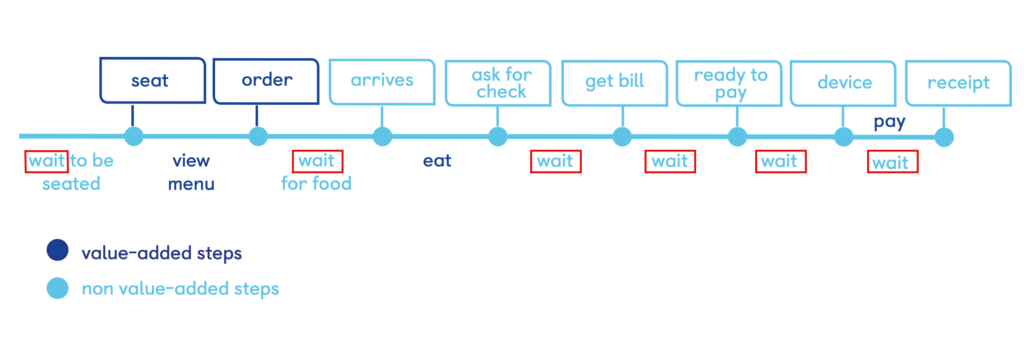[vc_row][vc_column][vc_column_text]
Why removing non-value added steps from the guest journey is key to unlocking your restaurant’s maximum revenue potential
Recently QikServe attended MURTEC, the annual multi-unit restaurant technology conference in Las Vegas, and was interested to see so many panel discussions and table topics pivot around the same issue: how to strip non-value added steps from the customer journey.
When we say ‘non-value added steps’, we mean all those moments in the guest journey that pose no great benefit for the guest and see operators losing money by the minute. In traditional fast casual or table-service restaurant (TSR) environments, these pain points tend to cluster around the stages of the journey that occur after the guest has been served.
 Each stamp represents a different stage in the journey. Light blue represents no or limited value for the operator or guest, while dark blue indicates high value points.
Each stamp represents a different stage in the journey. Light blue represents no or limited value for the operator or guest, while dark blue indicates high value points.
The stages of the table service journey that offer the most value for the guest and the operator are: getting seated, viewing the menu, ordering and paying. It is these areas where operators have the opportunity to really drive sales and enhance the guest experience. Every other point represents a potential wait or drag for customers and a manual action that a server has to take.
A recent report by point of sale provider Oracle shows 84% of customers rate a quick and efficient service as important in judging dining experiences, while 56% are willing to share data to receive a faster and more convenient service. And when you add to that the fact that on average it takes 12 minutes from asking for the check to paying, it becomes clear that there is a strong case for minimizing unnecessary wait times in TSRs.
Leaders in the restaurant technology industry are looking to eliminate dead time completely with solutions that automate the non-value added steps within the guest journey, leaving staff free to focus on high value interactions and empowering guests to control the timing of their service.
The most innovative way to achieve this is through in-store mobile order & pay technology, that is web-based meaning there are few barriers to adoption. With native applications – the traditional method for guests to order or pay at their tables using their phones – guests have to initially download the application then navigate a data entry wall which can cause a drop off as customers don’t want to release storage or data from their phones.
But with web-based mobile order & pay apps, guests simply scan a QR code or NFC tag at the table, launching a web application on their own devices where they can browse and order from the restaurant’s menu. They can also pay for their meal on the app by linking their Google, Apple Pay or by entering their card details.
By giving guests full control over the ordering and payment sections of the journey, the technology directly addresses seat, browse, eat and pay value-added points while omitting friction from all other parts of the journey.

Stages of the guest journey when an order & pay at table solution is incorporated.
Other benefits of at table solutions include an elimination of all EMV-related chargebacks, average transaction value increase of around 20% (through powerful upsell and cross sell functionality) zero hardware costs – guests run the solution on their own devices – and integration with third parties such as loyalty programs, to keep your customers coming back time and time again.
Find out more about Order & Pay At Table solutions here.[/vc_column_text][vc_separator color=”white”][/vc_column][/vc_row][vc_row][vc_column][/vc_column][/vc_row]





